This morning, we are up early and leaving for Cusco City. Unlike most of our trips where our small group of 10 have a private mini bus to ourselves, we take our small bus to a terminal in Puna to join a large tourist bus that will take us to Cusco.
This is a 50 passenger bus, we hold tickets 39- 50. We must have gotten the last tickets, and our group is in the very back. The bus has a toilet for number 1 only in an emergency, a guide, and a hostess who serves free soft drinks, water, and tea. None of us is looking forward to the ten hour bus ride to Cusco. I don't think any of us realized the vast distances between the ancient sites we have been visiting.
 Turns out that the drive was quite enjoyable, with many opportunities for drive-by candid photography of everyday people,
Turns out that the drive was quite enjoyable, with many opportunities for drive-by candid photography of everyday people,stops for restrooms, and at least five tourist stops to museums,
 |
| Inca Priest holding a sacrificial head |
 |
| Cattle - Good luck and symbols of fertility |
city centers,
pastoral settings,
Inca archeological sites,
 |
| Inca Temple |
 |
| Food Storage Facilities |
and churches.
 |
| Decked out for Holy Week |
We are at the end of the Holy week. In one church we stop in, a group of local Catholics including the priest are celebrating early with a bottle of rum and a shared shot glass in front of one of the processional displays in the church.
 |
| Happy Hour with a Bottle of Rum |
Everywhere we stopped, Mamas and their children in highland Peruvian costume (not their normal clothing) were selling and opportunity to take a photo with them, along with all kinds of touristy wares. The guide was very knowledgeable and his English understandable.
 |
| Alpaca Love....To Eat Hair and Hats |
We arrived in Cusco late in the day and transfer from the large bus to a small mini bus than can negotiate narrow streets. By the time we checked into our hotel the sun was setting. Our hotel is on an incredibly narrow street with side walks of less than a foot wide.
We are instructed to be very, very careful while walking on this street because of the heavy traffic, and be especially alert and try to step into a door frame when a tourist bus goes through because the extended side mirrors could take us out.
Because there is no place to park and when the bus stops to unload us and our luggage, we stop traffic until the bus is emptied. We scuttle out of the bus as if it were on fire, and the guide, driver, and hotel staff in bucket brigade style toss out the luggage. We are evacuated in less than three minutes, and there is a long line of traffic behind us.
Because there is no place to park and when the bus stops to unload us and our luggage, we stop traffic until the bus is emptied. We scuttle out of the bus as if it were on fire, and the guide, driver, and hotel staff in bucket brigade style toss out the luggage. We are evacuated in less than three minutes, and there is a long line of traffic behind us.
We check into the hotel at 5:40 and reconvene at 6:30 for an evening orientation walk and dinner. Our guide has made arrangements for a doctor to visit one of our group who is still quite ill. We return from our walk to the main square and dinner at local restaurant. Intrepid tours, sister to Peregrine tours promotes responsible socio-economic tourism. In India, we knew that part of our tour fee helped a women's cooperative paper making factory. We had the opportunity to visit the factory.
Here in Cusco, this particular restaurant matches the donation from Intrepid/Peregrine tours and a part of our tour fees plus a portion of our dinner bill to an abandon women and children's center in the highlands. Unfortunately, it is too far and too difficult for us to visit, but we know that by eating here, we are helping these women and children.
Cusco on Easter Eve.
There are many people milling about the square tonight. Tomorrow they will go to mass and Holy week will come to an end.














































